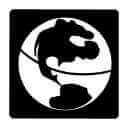
Glossary
This glossary is a list of words that will help you understand this website. Throughout the website, links will lead you to the glossary.
Word List
- Altitude
- Climate
- Data
- Density
- Electron microscope
- Field experiment
- Hemisphere
- Iliqqusiq
- Incident
- Lagoon
- Latitude
- Lead
- Longitude
- Maximum
- Melt Pond
- Microscope
- Minimum
- Phase
- Precipitation
- Prefix
- Pressure Ridge
- Reflected
- Sediment
- Unit
Altitude
Altitude tells you high above the surface something is. If a helicopter is flying at an altitude of 1,000 meters, that means it's 1,000 meters off the ground.
Back to Top
Climate
Climate is a general description of the weather for a certain place in the world. Weather describes what it's like outside right now, but climate describes what the weather is like over a whole year. That's why we read a weather report and not a "climate report" when we want to know if it will rain tomorrow! It usually takes a long time for a climate to change, so the climate in a place stays the same, no matter what the weather is right now.
Back to Top
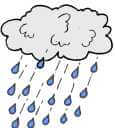
Data
Data is information, usually a bunch of numbers you get from measurements. Let's say you write down the temperature every morning for a three days and you get -10 C, -12 C, and -8 C. The numbers -10, -12, and -8 C are your data. For this project, you're collecting a few different kinds of data, including temperature data and snow depth data.
Back to Top
Density
The density of an object is the mass of the object divided by the volume of the object. Density has units of grams per centimeter cubed. The density of water is 1 gram per centimeter cubed.
Back to Top
Electron microscope
An electron microscope is a special kind of microscope designed for looking at very small objects. Instead of using lenses like regular microscopes, electron microscopes work by bouncing small particles, called electrons, off of an object. Scientists then use equipment to measure what happens to the electrons when they bounce off. Using this information, they can then tell what the object looks like.
Back to Top
Field experiment
A field experiment is an experiment that is done outside in the real world instead of inside a laboratory building. Field experiments don't have to be done in a field; they can happen anywhere outside, like on a mountain, near a lake, or on the ice!
Back to Top
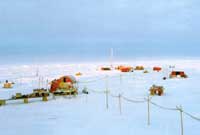
Hemisphere
Hemisphere literally means "half a globe." To make it easier to talk about where places are on the Earth, people pretend there is an imaginary line that goes around the Earth. This imaginary line is called the equator; it is the line across the Earth in the drawing. "Northern hemisphere" means the half of the globe that is north of the equator. "Southern hemisphere" means the half of the globe that is south of the equator. Which hemisphere do you live in?
Back to Top
Northern Hemisphere
Southern Hemisphere
Iliqqusiq
Illiqqusiq is a word that means the ways and habits of the Inuit." This includes everything from survival skills to games to arts to medicine.
Back to Top
Incident
When light comes from a source (like the sun or a light bulb) and hits something (like the earth or a tree), we call the light coming from the source "incident light." In the picture, the red arrows represent the incident sunlight.
Back to Top
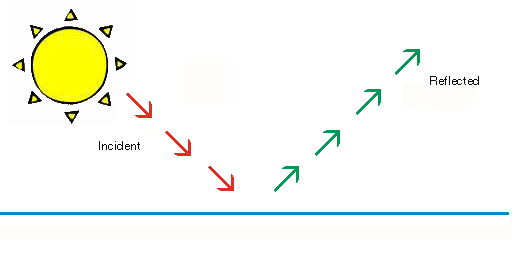
Lagoon
A lagoon is a big pond that isn't very deep. Lagoons are found near larger bodies of water, such as big lakes.
Back to Top
Latitude
The distance north or south of the earth's equator. 0 degrees latitude is the equator, the "belt" that goes around the "waist" of the earth. 90 degrees north is the North Pole and 90 degrees south is the South Pole.
Lines of latitude are blue (north) and red (nouth) in the drawing.
Back to Top
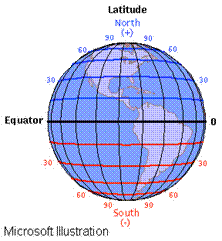
Lead
Leads are the places where we can see the ocean between sheets of sea ice in the arctic. From an airplane, leads look black or very dark blue. Sometimes leads form when sheets of ice break apart, which can be a problem for the scientists working on the ice!
Back to Top

Longitude
Angular distance on the earth's surface, measured east or west from the prime meridian at Greenwich, England.
Lines of longitude are blue (east) and red (west) in the drawing.
Back to Top
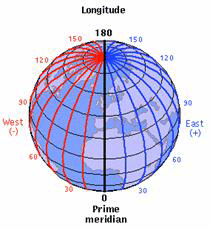
Maximum
The maximum is the largest number that is possible or allowed. For example, speed limit signs on the road tell you the maximum speed you're allowed to drive. Also, if you have a group of numbers, the maximum is the biggest number in the group.
Back to Top

Melt pond
A melt pond is a pond of water that forms on the surface of sea ice when it begins to melt in the summer. Melt ponds vary in size from very small to tens of thousands of square meters. The color of a melt pond depends mostly on the ice below it. Some ponds are bright blue, and others are almost black. Melt ponds sometimes melt all the way through the sea ice and down to the ocean.
Back to Top
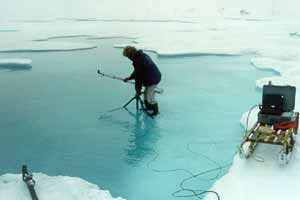
Microscope
Have you ever used glasses or a magnifying glass? Glasses and magnifying glasses use pieces of curved glass called lenses to make things look bigger. The word "microscope" means "to look at small things." Microscopes are what scientists use to see things that are very small. They work by using two very strong lenses in a row, so they make things look much bigger than a magnifying glass can. More on microscopes.
Back to Top

Minimum
The minimum is the smallest number that is possible or allowed. When someone asks what the minimum temperature was yesterday, they want to know what the lowest (coldest) temperature was for the whole day.
Back to Top
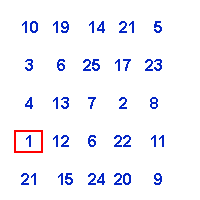
Phase
Water can be in three different forms, or phases: liquid, solid, and gas. The gas phase of water is vapor. We measure the amount of water vapor in the air in terms of the humidity. The solid phase of water is ice; water turns into ice when it gets cold (below 0 degrees Celsius). The liquid phase is the kind of water that comes out of a sink; water is a liquid when it is between 0 and 100 degrees Celsius. Vapor, ice, and liquid water are really all still water. The only difference is their phase.
Back to Top

Ice
![]()
Water

Vapor
Precipitation
Precipitation is water falling from the sky. It can be in the form of rain, or snow, or sleet, or hail.
Back to Top
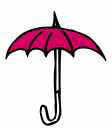
Prefix
A prefix is a group of letters that get added on the beginning of some words to change the meaning of the words. "Kilo-" means "thousand" and it's an example of a prefix. If you add "kilo-" to the word "meter," you get "kilometer," which is as big as a thousand meters. If you add "kilo-" to the word "gram," you get "kilogram," which is a thousand grams.
Back to Top
Pressure ridge
A pressure ridge is the big hill of ice that forms when two sheets of ice are pressed together. When two pieces of ice crunch together, there isn't any room for them to both keep floating on the water, so they get forced upward, making a ridge of ice. Can you find two things that you can push together to make a pressure ridge? (Hint: try using something thicker than paper. Make sure it's something that won't break! It helps if you make your pressure ridge on a slippery table.)
Back to Top

Reflected
When we say something is reflected, we mean it bounces off. When light hits something (like the earth or a tree), one of the things it can do is be reflected. This means it bounces off in a new direction. When our eyes look at an object, what they actually are seeing is the light which reflects off of the object. That's why you can't see very well in a dark room: there is very little light reflecting off the objects in the room. The green arrows in the picture represent reflected sunlight.
Back to Top

Sediment
Sediment is the stuff that settles at the bottom of a liquid. It can be all sorts of things, like dirt or rocks.
Back to Top
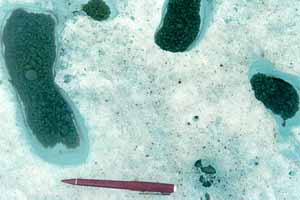
Unit
A unit is an amount that never changes. Because units always stay the same, we can use them to measure things. A meter is an example of a unit, because a meter is the same size everywhere in the world. That's why the meter is a useful measurement.
Back to Top
![]()


